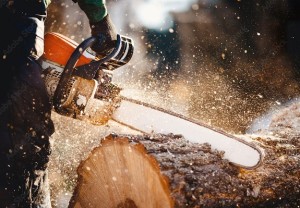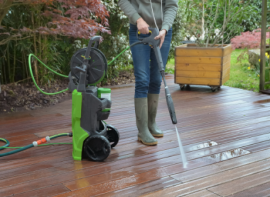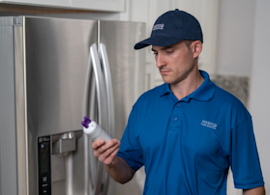How to prevent chainsaw injuries


The power that makes a chainsaw the tool of choice for cutting up tree limbs also makes it one of the most dangerous power tools homeowners commonly use. Each year, about 30,000 people are seen in hospital emergency rooms with chainsaw-related injuries, most commonly to the hands and legs. The following advice can help minimize the risk of chainsaw inuries.
For advice on repairing a chainsaw, see our chainsaw repair help.
Wear protective gear
Always wear safety gear, including steel-toed shoes, heavy-duty, nonslip gloves, eye and hearing protection and an ANSI-approved hard hat. Safety chaps are an excellent idea. That might seem excessive until you realize that the average chainsaw injury requires more than 110 stitches.
No one under age 16 should operate a chainsaw. This federal workplace regulation makes equally good sense at home.
Starting and stopping
When you start the engine, hold the chainsaw firmly on the ground, as directed in your
. Most manufacturers recommend putting your right foot through the rear handle and holding the front handle with your left hand. Make sure the chain has room to turn without hitting anything.
Never start the chainsaw when the guide bar is in a cut; remove it from the log first.
The chain should not move when the chainsaw is idling. If it does, the idle is set too high. Have a professional service the chainsaw.
Stop the engine before putting the chainsaw down.
Let the chainsaw cool for 30 minutes before refueling to prevent the gasoline from igniting.
Secure the wood
Don't stand on the log you're cutting or brace it with your leg or foot. Clear the area around the tree or branch so you can stand with both feet firmly on the ground.
Never let another person hold the log while you're cutting.
Support small logs on a sawhorse or sawbuck.
Cut with caution
Cut only one log at a time.
Never turn the chainsaw upside-down to make a cut from below. It's not designed to operate in this position and can be impossible to control.
Be careful when cutting wood that has splintered, because sharp pieces of wood can fly back at you. Also beware of branches that are bent or under pressure, which can spring back at you.
Don't put pressure on the chainsaw when finishing a cut, because you could lose control of the machine.
Don't make cuts from a ladder or when in a tree, and don't make cuts above shoulder height.
Avoid chainsaw kickback
Kickback—the cause of most major chainsaw injuries—happens when the chain jams and stops in the wood. In a fraction of a second, the trapped energy pops the guide bar out of the wood and throws the chainsaw back at you with tremendous force. By the time it reaches you, the chain has resumed its normal speed of about 60 miles an hour.
Equipment. The tip of the guide bar is prone to digging into the wood and jamming. When it does, the kickback sends the chainsaw up toward your head. To prevent this hazard, use a chainsaw with an anti-kickback chain and a tip guard that mounts on the end of the guide bar.
Pinching. A partially cut log can sag at the cut, pinching the chain and sending the chainsaw in the direction opposite the chain rotation, straight back toward your body. To prevent pinching, make cuts in two passes rather than one. Start on the side that would get pinched, cutting about one-quarter of the way through, and then finish the from the other side.
If the blade does get pinched, stop the chainsaw, insert a plastic or wood wedge in the cut to open it up and then remove the saw.
Body position. Position yourself so you won't be in the path of the chainsaw if it kicks back. Stand slightly to the left side of the chainsaw so that your body isn't directly in line with the guide bar.
Grip. You can use your grip to direct potential kickback away from you:
Keep both hands on the chainsaw while cutting.
Grip the rear handle with your right hand, whether you are right- or left-handed.
Wrap the fingers of your left hand over and around the front handlebar and wrap the thumb underneath.
Keep your left arm straight with the elbow locked.
Jeff Day is a freelance writer.
Symptoms for gas chainsaws
Choose a symptom to see related chainsaw repairs.
Main causes: stale gasoline, cracked fuel lines, dirty carburetor, damaged spark plug, worn piston rings…
Main causes: bad gas, engine needs tune up, cracked fuel lines, dirty carburetor…
Main causes: cracked fuel lines, leaky carburetor seals, damaged fuel tank cap, cracked fuel tank…
Repair guides for gas chainsaws
These step-by-step repair guides will help you safely fix what’s broken on your chainsaw.

How to rebuild a chainsaw carburetor
If your chainsaw isn't running well, a dirty carburetor could be the problem. You can take it apart, clean it and rebuil…

How to replace chainsaw fuel lines
The fuel line on a chainsaw becomes brittle over time and can crack. Replacing it doesn't require a lot of DYI experienc…

How to replace a chainsaw carburetor
If the engine won't start even though there's fuel in the chainsaw, the carburetor could be the problem. Sometimes, it's…
Articles and videos for gas chainsaws
Use the advice and tips in these articles and videos to get the most out of your chainsaw.

Learn about the top 10 must-have electric lawn & garden tools for 2023…

Learn about all the convenient features on our Sears PartsDirect website that make your parts purchases easier.…

Get answers to frequently asked questions about Sears and Sears PartsDirect.…